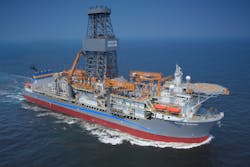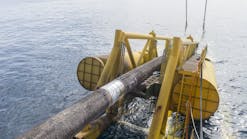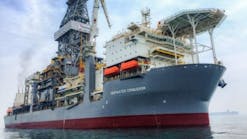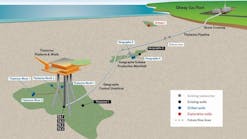Operators and developers working in the Gulf of Mexico have continued to advance their projects, even while the global oil market crashed and the Coronavirus pandemic wreaked havoc with global offshore E&P market.
In April, Equinor and co-venturers Progress Resources USA Ltd. and Repsol E&P USA Inc. reported that they encountered oil in the Monument exploration well in the central US Gulf of Mexico.
Drilled in Walker Ridge block 316, the well found about 200 ft (60 m) of net oil pay with good reservoir characteristics in Paleogene sandstone. This provides an early indication of the productive reservoir interval at the well location, the company said.
The drillship Pacific Khamsin drilled the well to a TD of 33,348 ft (10,164 m). Water depth is about 1,900 m (6,234 ft).
Bjørn Inge Braathen, senior vice president of Exploration in North America, said: “We are pleased to have proved an accumulation of movable hydrocarbons in the Monument exploration well. However, determining the full potential of the discovery will require further appraisal drilling.”
The Monument exploration well is operated by Equinor (50%) with partners Progress Resources USA Ltd. (30%) and Repsol E&P USA Inc. (20%).
Monument is Equinor’s first operated exploration well in the US Gulf of Mexico since 2015.
Mfon Usoro, senior research analyst at Wood Mackenzie, said: “In the current low oil price environment, Equinor’s Monument discovery is a welcome one for the partners – Repsol and Petronas subsidiary Progress Resources – and the wider US Gulf of Mexico. The discovery proves the mature region still has more life in it.”
Equinor has a strong footprint in the US Gulf of Mexico (largely in non-operated assets), but the company has indicated plans to become an operator in the region, with growth focused on Paleogene-rich resources.
Wood Mackenzie says that it expects Monument to be one of Equinor’s first commercialized discoveries in the Gulf. But the company could face technical challenges with the complex and often compartmentalized Paleogene reservoir. Based on the drill depth of more than 32,000 ft, the discovery could be similar to other ultra-high-pressure fields requiring 20,000 psi-rated equipment which indicates significantly higher development cost.
Exploration activity in 2020 has taken a hit as companies have quickly slashed budgets. It is likely that appraisal efforts at Monument will take a back seat until prices recover, according to Wood Mackenzie.
Meanwhile, Subsea 7 announced the award of contracts by Chevron U.S.A Inc. for subsea installation services related to the Anchor field in the Green Canyon area of the Gulf of Mexico. The Anchor field is about 140 mi off the coast of Louisiana.
Subsea 7’s scope of work includes project management, engineering, procurement, construction and installation of the SURF components including, but not limited to, the production flowlines, risers, umbilicals, flying leads, jumpers, and associated appurtenances.
Project management and engineering will commence immediately at Subsea 7’s offices in Houston. Fabrication of the flowlines and risers will take place at Subsea 7’s spool-base in Ingleside, Texas, with offshore operations anticipated to occur in 2022 and 2023.
In mid-April, Genesis Energy, L.P. said that it had entered into agreements to provide downstream transportation services for crude oil production associated with the deepwater Gulf of Mexico Katmai field development, through the existing Tarantula production platform.
The agreements are with Fieldwood Energy LLC, Ridgewood Katmai, LLC and ILX Prospect Katmai, LLC, two entities managed by Ridgewood Energy Corp. The existing Tarantula production platform is owned by Fieldwood.
The Tarantula platform, located in South Timbalier block 308, has the capability to process up to 25,000 b/d of oil from the Katmai field development. The Katmai field development is in Green Canyon blocks 39 and 40.
The Tarantula platform is currently connected to the Tarantula lateral and the crude oil production will be delivered to the Poseidon crude oil system for delivery to shore. First deliveries of oil are anticipated in the second quarter of this year. •






